We all experience moments of emotional distress, whether it's from past trauma, daily stress, or life transitions. When these emotions weigh heavily on us, finding ways to process and heal becomes essential.
While there are numerous forms of therapy, one powerful tool that has emerged is art therapy, particularly through painting.
For those of us struggling with emotional challenges, the creative act of painting offers more than just an artistic outlet—it provides a path to healing and self-discovery. In this article, we will explore how painting can be a therapeutic tool that helps us heal from emotional wounds and manage psychological stress.
Art Therapy: A Brief Overview
Art therapy is a well-established psychological practice that uses the creative process of making art to help individuals explore their emotions, improve self-awareness, and reduce stress. The key idea behind art therapy is that the act of creating art is a form of self-expression, helping individuals communicate feelings and experiences that may be difficult to verbalize. For us, the creative process becomes an avenue for healing, offering a safe space to explore our inner world without fear of judgment.
Art therapists, who are trained professionals, guide clients through this process, helping them use different forms of art—painting, drawing, sculpture, and more—to express themselves. While we can all create art in our own way, having professional support allows us to deepen our understanding of what we are experiencing and why certain images or colors emerge during our artistic process.
How Painting Helps Alleviate Psychological Stress
Painting, in particular, offers unique benefits for mental health. For many of us, painting becomes a form of mindfulness—a way to focus our attention on the present moment. As we dip our brushes in paint, we leave behind the worries of the day and immerse ourselves in the creative flow. This can be incredibly calming, as it helps us step away from racing thoughts and engage in an activity that brings us into the here and now.
The process of painting can also serve as a distraction, giving us a healthy way to channel our stress. Instead of ruminating on negative emotions, we can redirect our energy into creating something tangible. This act of creation can bring a sense of accomplishment and pride, boosting our mood and giving us a sense of control over our emotional state.
Furthermore, certain colors and shapes used in paintings can have specific psychological effects. For example, calm and soothing colors like blues and greens can induce relaxation, while bold colors like reds and yellows can evoke energy and motivation. Through painting, we can intuitively choose colors that reflect our current emotions, allowing us to understand and process our feelings more deeply.
Processing Trauma Through Creative Expression
One of the most powerful aspects of painting as a therapeutic tool is its ability to help individuals process trauma. For many, traumatic experiences are too overwhelming to talk about directly, and the emotions surrounding these events can remain buried for years. Art therapy provides a non-verbal way of expressing complex feelings that may be hard to articulate.
When we paint, we may find that certain themes or symbols emerge on the canvas—things we didn't consciously intend but that reflect deep emotional truths. These images can be metaphors for trauma, such as turbulent waves for emotional turmoil or dark shadows for feelings of fear and isolation. By visually representing these emotions, we gain a new perspective on them, allowing us to begin the healing process.
Additionally, painting can help us reframe our trauma. By creating a visual narrative, we gain the power to reimagine our experiences. This process can be empowering, as it gives us the ability to control how we perceive and process our past.
Self-Healing Mechanisms in the Creative Process
The act of creating art itself can be a form of self-healing. As we engage with the painting process, we tap into our own inner resources, fostering resilience and emotional growth. There is a sense of catharsis that often accompanies the act of putting emotions onto paper or canvas. This release of pent-up emotions can bring clarity and relief, making us feel lighter and more at peace.
In addition to catharsis, painting helps us engage in a process of self-reflection. By looking at our artwork, we gain insight into our subconscious mind. We may notice patterns, symbols, or recurring themes that can shed light on our emotional state. This self-awareness is an important part of healing, as it allows us to better understand our triggers and responses.
The satisfaction of completing a painting also provides a sense of accomplishment, which can improve self-esteem and reinforce positive emotions. For many of us, creating art becomes a way to reclaim our power and control, helping us move through difficult emotions with more ease.
The Impact on Mental Health
Scientists have proven that art therapy, including painting, can significantly reduce symptoms of anxiety, depression, and PTSD (Post-Traumatic Stress Disorder). A study published in the "Journal of the American Art Therapy Association" in 2004 found that participants who engaged in art therapy experienced decreased levels of stress and anxiety, as well as improved emotional regulation and coping skills. These findings confirm what many of us have felt intuitively—that creating art can be a profound way to heal and manage mental health.
While painting isn't a replacement for professional mental health treatment, it can certainly serve as a complementary tool in the healing process. For individuals working through trauma or emotional challenges, painting offers a way to process emotions in a safe, creative space. It provides an alternative way to heal when words alone feel inadequate.
Conclusion: Embracing Painting for Healing
Painting is more than art—it’s a powerful tool for healing. Whether facing stress, anxiety, or trauma, painting helps express emotions and process feelings. It offers self-reflection, emotional release, and empowerment.
You don’t need to be an artist to benefit. The goal isn’t perfection but healing. Pick up a brush and let painting nurture your mental well-being. Give it a try—you might find unexpected peace and growth.


